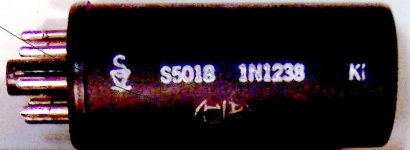Hm, quite a few hits on Google, though no datasheets yet. Looks to be a replacement for 5U4/5Y3/etc. (any rectifier with that base), rated 1600PIV 0.75A (probably total DC output, not per diode; two series pairs of 1N4007s would be rated 2kV, 2A the same way).
Depending on how old it is, it might be worth something. Or just a piece of junk. *shrug*
Tim
Depending on how old it is, it might be worth something. Or just a piece of junk. *shrug*
Tim
Sakes/Tarzain is a name out of my youth. I can remember when they introduced 500 mA. Silicon diodes that mounted in 3AG fuse holders.
That device is "2" diodes mounted on an Octal socket with a covering can. That the B+ is somewhat higher is to be expected, as PN diodes have a MUCH lower forward voltage drop than vacuum diodes do. Expect a considerable amount of switching noise from those old diodes. If your amp's PSU has a choke in its filter, the noise is removed from the B+. In any event, switching noise could get into the signal path via filament windings on the power trafo.
If you like, run a Google search against 1N????, as that's the part number.
That device is "2" diodes mounted on an Octal socket with a covering can. That the B+ is somewhat higher is to be expected, as PN diodes have a MUCH lower forward voltage drop than vacuum diodes do. Expect a considerable amount of switching noise from those old diodes. If your amp's PSU has a choke in its filter, the noise is removed from the B+. In any event, switching noise could get into the signal path via filament windings on the power trafo.
If you like, run a Google search against 1N????, as that's the part number.
That device is "2" diodes mounted on an Octal socket with a covering can. That the B+ is somewhat higher is to be expected, as PN diodes have a MUCH lower forward voltage drop than vacuum diodes do. Expect a considerable amount of switching noise from those old diodes. If your amp's PSU has a choke in its filter, the noise is removed from the B+. In any event, switching noise could get into the signal path via filament windings on the power trafo.
I believe the Tarzian units have a voltage dropping resistor inside as well. They generally have part numbers as drop-in replacements for a variety of tube rectifiers. I have seen many of these used in FAA euipment where application is critical.
John
- Status
- Not open for further replies.
